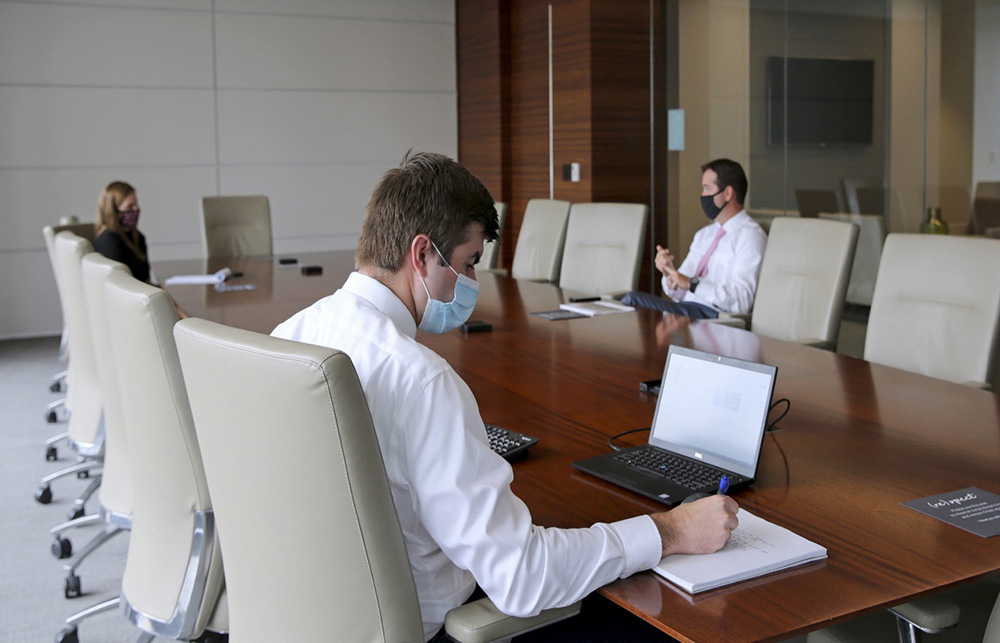
各大公司針對新冠疫情期間遠程工作的雇員推出了疫情后政策,成為新聞媒體爭相報道的內容。福特(Ford)預見的是一種混合工作模式。推特(Twitter)已經告知眾多遠程工作的雇員,他們可以一直采用這種模式。摩根士丹利(Morgan Stanley)則在計劃“全面回歸”辦公室,并提供一些居家工作選項。總而言之,這些計劃可謂是五花八門。
與此同時,疫情導致雇員遠程工作了一年的時間,這個實驗對他們的影響可謂是喜憂參半。盡管很多雇員喜歡居家工作,并希望至少在一部分時間中繼續(xù)保持這種模式,但最近微軟(Microsoft)的一份報告顯示,54%的雇員稱他們感到自己在超負荷工作,同時有39%的雇員感到疲憊不堪。出現(xiàn)這種感受的一個原因在于:研究發(fā)現(xiàn),雇員面臨著數(shù)字協(xié)作的大幅上升,包括遠程會議、電子郵件、聊天以及團組的協(xié)同文件制作。
公司和員工自身釋放的信號發(fā)生了沖突,在這種情況下,高管們如何確定哪些政策最適合其機構的白領雇員?作為研究靈活工作動議的學者,我們知道應該如何制定“混合模式”政策,這些政策將混合遠程與辦公室工作,而且長期有效,不會讓雇員產生倦怠情緒。
疫情之前,我們圍繞創(chuàng)新工作再設計方法開展了一項五年期的深度研究,對象是一家曾經助推大部分員工居家工作的《財富》美國500強公司。這家公司將遠程工作看作是其更廣泛戰(zhàn)略中的一個要素,目的是為了創(chuàng)建更好的工作方式。
我們在研究中發(fā)現(xiàn),逐漸向遠程工作模式轉換不應該是工作再設計的唯一關注點。如果一項政策宣布雇員必須遠程工作,或甚至規(guī)定雇員應該能夠隨時隨地開展工作,那么這項政策將造成工作時長增加以及全天候待命的壓力,并在一段時間后讓員工產生倦怠心理。
我們研究的這個計劃有兩個重要組件:培訓經理應該轉變其看待自身職責的方式;幫助團隊發(fā)現(xiàn)和減少低價值工作。經理們會獲得培訓,內容包括鼓勵其表達支持雇員個人生活,以及明確表達績效目標和期許,這樣,他們便可以專注于監(jiān)控業(yè)績而不是辦公室的“露面時間”。
第二,結構化的團隊討論有助于超負荷運轉的雇員發(fā)現(xiàn)自身作為個人和團隊成員能夠做出的調整,例如減少會議數(shù)量或所需的參會人數(shù)。這類工作再設計方法最終將改變日常工作實踐,包括提升遠程工作的能力,同時還可以發(fā)現(xiàn)團隊能夠減少的低價值工作,并保持工作時長不變。
我們的研究團隊發(fā)現(xiàn)這些變化改善了雇員和經理的福祉以及工作與生活之間的結合狀況,提升了工作滿意度,并通過減少與重要員工跳槽相關的成本讓公司受益。整體來看,我們的研究發(fā)現(xiàn),工作再設計項目每支出1美元,公司就可以節(jié)省1.68美元的費用,這對投資來說是一個十分健康的回報。
然而,類似福利僅在雇員感到他們能夠選擇工作地點和時間時才可以實現(xiàn),而不是將特定的遠程和辦公室工作混合模式強加給員工。此外,經理和同事應該尊重員工的個人和家庭情況,這一點至關重要。換句話說,我們在研究中發(fā)現(xiàn)的這些福利并非來自于允許遠程工作的政策,而是獲得掌控和支持的感覺。
說到疫情過后應該怎么做的決策,挑戰(zhàn)與機遇是并存的。疫情已經打破了老舊的模式,不僅能夠讓人們進行遠程工作,獲得更靈活的工作日程,同時也為重新評估此前想當然的工作模式提供了機會。
我們預計,大多數(shù)雇員和經理會傾向于在今后采用遠程+辦公室工作的混合模式,就像我們在研究中所發(fā)現(xiàn)的那樣。然而,具體應該采取什么樣的比例,可能還得取決于正在開展的工作以及雇員的個人生活。不過,單純的居家工作可能僅適用于某些雇員和職位。我們的研究發(fā)現(xiàn),可以在一定的時間內選擇何時、何地以及如何工作受到眾多雇員的高度重視,而且可能有助于提振公司的利潤。
我們在研究中部署的工作再設計方法并未通過創(chuàng)建正式的政策來確定應該在辦公室工作多長時間,或要求個人在居家工作之前獲得其經理的許可。定期開展對話,了解員工希望如何工作以及團隊如何協(xié)同發(fā)揮其最大效力,將為打造適應性強、有針對性的工作方式奠定基礎。
當前是啟動工作再設計項目的絕佳時期,就像我們在研究中所做的那樣——邀請團隊討論和學習如何在疫情期間自我調整以及自己遇到的困難,并設想適用于團隊的工作方式。我們已經根據(jù)研究結果,創(chuàng)建了免費的培訓資源,包括實施這類工作再設計項目的導師指南。
我們的研究得出了一個明確的結論:不要讓自己的機構錯過這個通過工作再設計來改善自身的機會。(財富中文網(wǎng))
艾琳?凱麗是麻省理工學院斯隆管理學院(MIT Sloan School of Management)工作與機構研究的斯隆杰出教授。
菲利斯?摩恩是明尼蘇達大學(University of Minnesota)社會學McKnight講座教授。
他們是《超負荷:當好工作變壞之際,我們應該如何應對》(Overload: How Good Jobs Went Bad and What We Can Do About It.)一書的作者。
譯者:馮豐
審校:夏林
各大公司針對新冠疫情期間遠程工作的雇員推出了疫情后政策,成為新聞媒體爭相報道的內容。福特(Ford)預見的是一種混合工作模式。推特(Twitter)已經告知眾多遠程工作的雇員,他們可以一直采用這種模式。摩根士丹利(Morgan Stanley)則在計劃“全面回歸”辦公室,并提供一些居家工作選項。總而言之,這些計劃可謂是五花八門。
與此同時,疫情導致雇員遠程工作了一年的時間,這個實驗對他們的影響可謂是喜憂參半。盡管很多雇員喜歡居家工作,并希望至少在一部分時間中繼續(xù)保持這種模式,但最近微軟(Microsoft)的一份報告顯示,54%的雇員稱他們感到自己在超負荷工作,同時有39%的雇員感到疲憊不堪。出現(xiàn)這種感受的一個原因在于:研究發(fā)現(xiàn),雇員面臨著數(shù)字協(xié)作的大幅上升,包括遠程會議、電子郵件、聊天以及團組的協(xié)同文件制作。
公司和員工自身釋放的信號發(fā)生了沖突,在這種情況下,高管們如何確定哪些政策最適合其機構的白領雇員?作為研究靈活工作動議的學者,我們知道應該如何制定“混合模式”政策,這些政策將混合遠程與辦公室工作,而且長期有效,不會讓雇員產生倦怠情緒。
疫情之前,我們圍繞創(chuàng)新工作再設計方法開展了一項五年期的深度研究,對象是一家曾經助推大部分員工居家工作的《財富》美國500強公司。這家公司將遠程工作看作是其更廣泛戰(zhàn)略中的一個要素,目的是為了創(chuàng)建更好的工作方式。
我們在研究中發(fā)現(xiàn),逐漸向遠程工作模式轉換不應該是工作再設計的唯一關注點。如果一項政策宣布雇員必須遠程工作,或甚至規(guī)定雇員應該能夠隨時隨地開展工作,那么這項政策將造成工作時長增加以及全天候待命的壓力,并在一段時間后讓員工產生倦怠心理。
我們研究的這個計劃有兩個重要組件:培訓經理應該轉變其看待自身職責的方式;幫助團隊發(fā)現(xiàn)和減少低價值工作。經理們會獲得培訓,內容包括鼓勵其表達支持雇員個人生活,以及明確表達績效目標和期許,這樣,他們便可以專注于監(jiān)控業(yè)績而不是辦公室的“露面時間”。
第二,結構化的團隊討論有助于超負荷運轉的雇員發(fā)現(xiàn)自身作為個人和團隊成員能夠做出的調整,例如減少會議數(shù)量或所需的參會人數(shù)。這類工作再設計方法最終將改變日常工作實踐,包括提升遠程工作的能力,同時還可以發(fā)現(xiàn)團隊能夠減少的低價值工作,并保持工作時長不變。
我們的研究團隊發(fā)現(xiàn)這些變化改善了雇員和經理的福祉以及工作與生活之間的結合狀況,提升了工作滿意度,并通過減少與重要員工跳槽相關的成本讓公司受益。整體來看,我們的研究發(fā)現(xiàn),工作再設計項目每支出1美元,公司就可以節(jié)省1.68美元的費用,這對投資來說是一個十分健康的回報。
然而,類似福利僅在雇員感到他們能夠選擇工作地點和時間時才可以實現(xiàn),而不是將特定的遠程和辦公室工作混合模式強加給員工。此外,經理和同事應該尊重員工的個人和家庭情況,這一點至關重要。換句話說,我們在研究中發(fā)現(xiàn)的這些福利并非來自于允許遠程工作的政策,而是獲得掌控和支持的感覺。
說到疫情過后應該怎么做的決策,挑戰(zhàn)與機遇是并存的。疫情已經打破了老舊的模式,不僅能夠讓人們進行遠程工作,獲得更靈活的工作日程,同時也為重新評估此前想當然的工作模式提供了機會。
我們預計,大多數(shù)雇員和經理會傾向于在今后采用遠程+辦公室工作的混合模式,就像我們在研究中所發(fā)現(xiàn)的那樣。然而,具體應該采取什么樣的比例,可能還得取決于正在開展的工作以及雇員的個人生活。不過,單純的居家工作可能僅適用于某些雇員和職位。我們的研究發(fā)現(xiàn),可以在一定的時間內選擇何時、何地以及如何工作受到眾多雇員的高度重視,而且可能有助于提振公司的利潤。
我們在研究中部署的工作再設計方法并未通過創(chuàng)建正式的政策來確定應該在辦公室工作多長時間,或要求個人在居家工作之前獲得其經理的許可。定期開展對話,了解員工希望如何工作以及團隊如何協(xié)同發(fā)揮其最大效力,將為打造適應性強、有針對性的工作方式奠定基礎。
當前是啟動工作再設計項目的絕佳時期,就像我們在研究中所做的那樣——邀請團隊討論和學習如何在疫情期間自我調整以及自己遇到的困難,并設想適用于團隊的工作方式。我們已經根據(jù)研究結果,創(chuàng)建了免費的培訓資源,包括實施這類工作再設計項目的導師指南。
我們的研究得出了一個明確的結論:不要讓自己的機構錯過這個通過工作再設計來改善自身的機會。(財富中文網(wǎng))
艾琳?凱麗是麻省理工學院斯隆管理學院(MIT Sloan School of Management)工作與機構研究的斯隆杰出教授。
菲利斯?摩恩是明尼蘇達大學(University of Minnesota)社會學McKnight講座教授。
他們是《超負荷:當好工作變壞之際,我們應該如何應對》(Overload: How Good Jobs Went Bad and What We Can Do About It.)一書的作者。
譯者:馮豐
審校:夏林
The news is full of announcements about companies’ post-pandemic policies for employees who have been working remotely throughout the pandemic. Ford foresees a hybrid model. Twitter has told many employees working remotely that they can do so indefinitely. Morgan Stanley plans a “full return” to the office, with some work-from-home options. In short, these plans are all over the map.
Meanwhile, the yearlong, pandemic-induced remote work experiment has had mixed effects on employees. Although many like working from home and want to continue to at least part of the time, a recent Microsoft report found that 54% of employees say they feel overworked, while 39% feel exhausted. One reason for those feelings of exhaustion: The study found that employees are facing a dramatic increase in digital collaboration, including remote meetings, email, chats, and groups working on documents together.
Given these conflicting signals from both companies and workers themselves, how can executives determine optimal policies for their organization’s white-collar employees going forward? As scholars who research flexible work initiatives, we have insights into how to make “hybrid” policies, which blend remote and in-office work, effective over the long haul, without burning out employees.
Before the pandemic, we conducted a five-year, in-depth study of an innovative work redesign approach at a Fortune 500 company that facilitated extensive work from home—but treated remote work as just one element in a broader strategy to craft a better way of working.
One lesson from our research is that shifting to remote work should not be the only focus of work redesign. A policy declaring that people must work remotely, or even one saying they can work whenever and wherever they want, can easily become pressure to work longer hours and be available 24/7—leading to burnout over time.
Two important elements of the initiative we studied were training managers to shift how they approached their roles and helping teams identify and reduce low-value work. Managers received training encouraging them both to express support of employees’ personal lives and to clearly articulate performance goals and expectations, so that they could focus on monitoring results rather than “face time” at the office.
Secondly, structured team discussions helped overloaded employees identify changes they could make as individuals and teams, such as reducing the number of meetings or the number of people required to attend them. This work redesign approach ultimately changed everyday work practices, including increasing the ability to work remotely, while also identifying low-value work that teams can reduce and still hold work hours steady.
Our research team found these changes improved well-being and work/life integration for employees and managers, increased job satisfaction, and benefited the company by reducing the costs associated with turnover among valuable employees. Overall, our study found that for every $1 spent on the work redesign program, the company saw about $1.68 in savings—a healthy return on investment.
But such benefits arise only when employees feel they can choose where and when they work—not by mandating some particular mix of remote and in-office work. It is also critical that managers and coworkers respect workers’ personal and family situations. In other words, the benefits we document come not from a policy allowing remote work per se, but from gaining a sense of control and support.
The post-COVID decisions about what to do next represent a challenge, but also an opportunity. The pandemic has disrupted old patterns, opening up possibilities for not only remote work or more flexible schedules, but for reassessing previously taken-for-granted ways of working.
We expect most employees and managers will prefer some blend of remote and in-office work going forward, as they did in our study. The exact mix may depend on the work being done and the personal lives of the workforce, but working at home exclusively only works well for some employees and roles. However, our research shows that having some say in when, where, and how they work is highly valued by many employees, and can be good for a company’s bottom line.
The work redesign approach deployed in our study did not set up formal policies laying out how much time was expected in the office or requiring individuals to get permission from their managers to work from home. Instead, regular conversations about how people hoped to work and how the team could coordinate to do its best work set the stage for adaptable and customized ways of working.
This is the perfect moment to launch a work redesign initiative like the one we researched—inviting teams to discuss and learn from how they adapted during the pandemic and how they struggled, and to imagine what might work well for them. We’ve created free training resources from our study, including a facilitator’s guide to implementing this kind of work redesign program.
The takeaway from our research is clear: Don’t let this opportunity to redesign work for the better pass your organization by.
Erin L. Kelly is the Sloan distinguished professor of work and organization studies at the MIT Sloan School of Management.
Phyllis Moen holds the McKnight endowed presidential chair in sociology at the University of Minnesota.
They are the authors of Overload: How Good Jobs Went Bad and What We Can Do About It.






